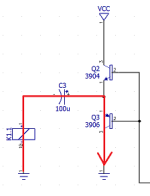I bought my first relay and a momentary foot switch and was wondering if i would be able to get it to work with out the microcontroller IC . i was thinking i could make some kind of flip flop with transistors to change the polarity through my relay coil and toggle that with my momentary foot switch but i have no idea how to do that. i was hoping someone might be able to point me to a schematic i can study or if i will in fact need the microcontroller IC/ PCB. thank you for any advice on this topic.
(Fixxed) Kemet EA2-5SNJ relay
- Thread starter Crispy
- Start date



